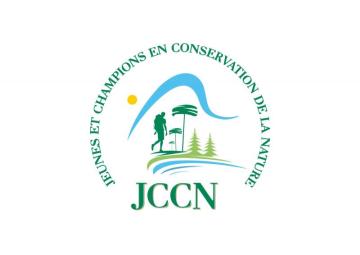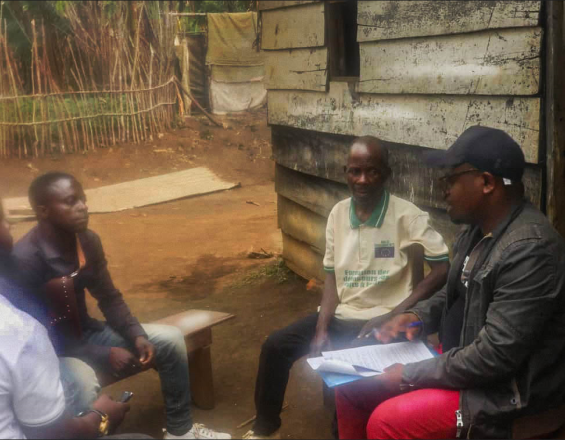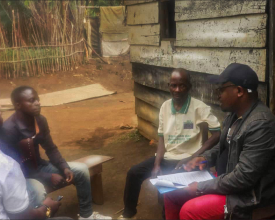
La conservación de la biodiversidad por los pueblos autóctonos y las comunidades locales en APAC LUWE-ITOTA

Luwe-Itota es el único aire y territorio de pueblos y comunidades autóctonos (APAC) identificado hasta la fecha en la provincia de Sud-Kivu, que forma parte de la red de APAC gestionada por la Alianza Nacional de Apoyo y Promoción de los Aires y Territorios del Patrimonio Autóctono y Comunitario (ANAPAC). Situada al este de la República Democrática del Congo, sobre las montañas que rodean la parte occidental de la Reserva Natural de Itombwe (RNI), la zona tiene una superficie total estimada de 527 ha. Está localizada en su totalidad en la zona de Basile, en el couloir écologique ouest de la réserve naturelle d'Itombwe. El APAC Luwe-Itota, territorio de vida de los pueblos autóctonos tradicionalmente protegido por los pueblos autóctonos y las comunidades locales, contribuye al mantenimiento de la integración ecológica y a la conservación de la biodiversidad en el paisaje de la Reserva Natural de Itombwe.
Contexto
Défis à relever
En cuanto a los problemas, se señalan actividades de agricultura itinerante sobre brulotes que diezman algunas extensiones forestales de la zona abarcada por el APAC. También se observan prácticas de caza no controladas. Por el momento se han denunciado algunos casos de explotación semiindustrial de la madera por parte de troncos, lo que podría poner en peligro gran parte de los bosques de esta zona bajo la gestión de los pueblos autóctonos, a falta de sanciones culturales y de normas y prácticas tradicionales de gestión de los recursos naturales.
Ubicación
Procesar
Resumen del proceso
Como todas las áreas protegidas locales y autóctonas, el APAC Luwe-Itota está gestionado tradicionalmente por miembros de las comunidades locales y pueblos autóctonos. Las decisiones sobre la gestión del sitio las toma el órgano denominado APACLI (Aire del Patrimonio Autóctono y Comunitario Luwe-Itota), que reúne a los representantes de distintas familias. En caso de violación de las normas comunitarias en materia de gestión de los recursos naturales, los guardas de monumentos reunidos en consejo en el Barza imponen sanciones administrativas. Las decisiones sobre los tipos de beneficiarios de las distintas ayudas las toman los miembros del APACLI, reunidos en asamblea.
Bloques de construcción
Compromiso comunitario y gestión tradicional de los recursos
La APAC Luwe-Itota se beneficia de un modo de gobierno de las comunidades locales y los pueblos autóctonos
Factores facilitadores
El acceso y la utilización de los recursos naturales se basan en normas y prácticas tradicionales y consuetudinarias.
Lección aprendida
Los mecanismos tradicionales de utilización de los recursos naturales contribuyen a la conservación de la biodiversidad.
Colaboración con la ANAPAC y existencia de una estructura local de gestión del sitio (APACLI)
El yacimiento está gestionado tradicionalmente por las autoridades competentes; agrupadas en el seno del organismo denominado APACLI (Aire del Patrimonio Autóctono y Comunitario Luwe-Itota).
Factores facilitadores
APACLI agrupa a todas las autoridades competentes y a los jefes de familia de los propietarios de tierras.
Lección aprendida
La creación de APACLI como órgano de gestión permite a todas las familias participar en la gestión del sitio.
Impactos
El APAC Luwe-Itota contribuye al mantenimiento de la integración ecológica y a la conservación de la biodiversidad en la Reserva Natural de Itombwe. El modo de gestión ofrece muchas ventajas a las comunidades locales y autóctonas. Los miembros de la comunidad disponen de derechos de acceso a los recursos naturales de forma tradicional. En este caso, la comunidad cuenta con ayudas a la resiliencia socioeconómica aportadas por diversos socios, entre ellos la ANAPAC.
Beneficiarios
Los beneficiarios son los pueblos autóctonos, las comunidades locales, los socios técnicos y financieros, los investigadores, los miembros de la sociedad civil y los activistas medioambientales.
Objetivos de Desarrollo Sostenible
Historia
Luwe-Itota es el único aire y territorio de pueblos y comunidades autóctonos (APAC) identificado hasta la fecha en la provincia de Sud-Kivu, que forma parte de la red de APAC gestionada por la Alianza Nacional de Apoyo y Promoción de los Aires y Territorios del Patrimonio Autóctono y Comunitario (ANAPAC). Situada al este de la República Democrática del Congo, sobre las montañas que rodean la parte occidental de la Reserva Natural de Itombwe (RNI), la zona tiene una superficie total estimada de 527 ha. Está localizada en su totalidad en la zona de Basile, en el couloir écologique ouest de la réserve naturelle d'Itombwe. El APAC Luwe-Itota es un territorio habitado por pueblos autóctonos y está gestionado por los pueblos autóctonos y las comunidades locales. Como cualquier otra APAC, su promoción pretende reforzar el proceso de conservación de la biodiversidad y de los hábitats naturales mediante una gestión y una utilización tradicionalmente duraderas de los recursos naturales. Con el apoyo de la ANAPAC y de la organización "Programa Integrado para el Desarrollo de los Pueblos Autóctonos Pigmeos (PIDEP)", el sitio está gestionado de forma tradicional por las poblaciones autóctonas y los miembros de las comunidades locales reunidos en la estructura denominada APACLI (Aire del Patrimonio Autóctono y Comunitario Luwe-Itota).
Por su ubicación en la parte dorsal occidental de la cuenca alpina, la zona que incluye Luwe-Itota está caracterizada por bosques secundarios y primarios de montaña y de altitud media que albergan una gran diversidad de hábitats, incluidos bosques marinos propicios para la vida de numerosas especies animales. Los bosques de Luwe-Itota son hábitats predilectos de chimpancés y solteros y constituyen zonas de refugio de gorilas en la Reserva Natural de Itombwe. Estos bosques son también fuente de numerosos productos forestales no leñosos (PFNL), entre los que destacan las cerezas comestibles, las plantas alimenticias salvajes, los champiñones, las plantas medicinales, la madera de choza, etc., de los que dependen los miembros de las comunidades propietarias.



